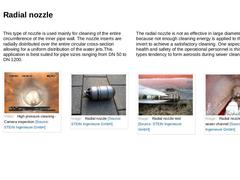
|
This type of nozzle is used mainly for cleaning of the entire circumference of the inner pipe wall. The nozzle inserts are radially distributed over the entire circular cross-section allowing for a uniform distribution of the water jets.This application is best suited for pipe sizes ranging from DN 50 to DN 1200. The radial nozzle is not as effective in large diameter channels because not enough cleaning energy is applied to the pipe invert to achieve … |
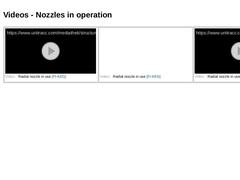
|
Video: Radial nozzle in use [FI-KEG]. This object is only visible in the online version of the module. Video: Radial nozzle in use [FI-KEG]. This video is only visible in the online version of the module. Video: Radial nozzle in use [FI-KEG]. This video is only visible in the online version of the module. |
(Video: Radial nozzle in use) |
(Video: Radial nozzle in use) |
(Video: Radial nozzle in use) |
|
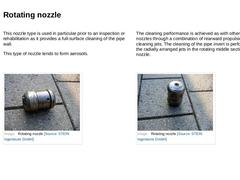
|
This nozzle type is used in particular prior to an inspection or rehabilitation as it provides a full-surface cleaning of the pipe wall. This type of nozzle tends to form aerosols. The cleaning performance is achieved as with other types of nozzles through a combination of rearward propulsion and cleaning jets. The cleaning of the pipe invert is performed by the radially arranged jets in the rotating middle section of the nozzle. |
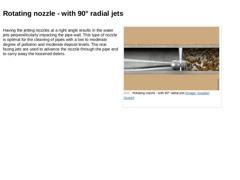
|
Having the jetting nozzles at a right angle results in the water jets perpendicularly impacting the pipe wall. This type of nozzle is optimal for the cleaning of pipes with a low to moderate degree of pollution and moderate deposit levels. The rear facing jets are used to advance the nozzle through the pipe and to carry away the loosened debris. (Image: Rotating nozzle - with 90° radial jets) |
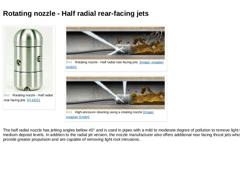
|
(Image: Rotating nozzle - Half radial rear-facing jets) (Image: Rotating nozzle - Half radial rear-facing jets) (Image: High-pressure cleaning using a rotating nozzle) The half radial nozzle has jetting angles bellow 45° and is used in pipes with a mild to moderate degree of pollution to remove light to medium deposit levels. In addition to the radial jet version, the nozzle manufacturer also offers additional rear facing thrust jets which provide greater … |
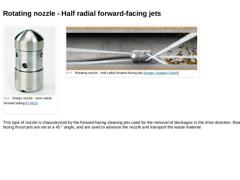
|
(Image: Rotary nozzle - semi radial - forward jetting) (Image: Rotating nozzle - Half radial forward-facing jets) This type of nozzle is characterized by the forward-facing cleaning jets used for the removal of blockages in the drive direction. Rear-facing thrust jets are set at a 45 ° angle, and are used to advance the nozzle and transport the waste material. |
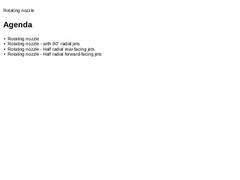
|
|
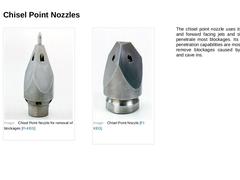
|
(Image: Chisel Point Nozzle for removal of blockages) (Image: Chisel Point Nozzle) The chisel point nozzle uses its multiple rear and forward facing jets and sharp edges to penetrate most blockages. Its geometry and penetration capabilities are most often used to remove blockages caused by pipe failures and cave ins. |

|
|
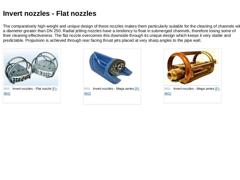
|
The comparatively high weight and unique design of these nozzles makes them particularly suitable for the cleaning of channels with a diameter greater than DN 250. Radial jetting nozzles have a tendency to float in submerged channels, therefore losing some of their cleaning effectiveness. The flat nozzle overcomes this downside through its unique design which keeps it very stable and predictable. Propulsion is achieved through rear facing thrust … |
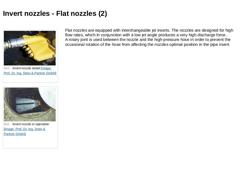
|
(Image: Invert nozzle detail) (Image: Invert nozzle in operation) Flat nozzles are equipped with interchangeable jet inserts. The nozzles are designed for high flow rates, which in conjunction with a low jet angle produces a very high discharge force.
A rotary joint is used between the nozzle and the high-pressure hose in order to prevent the occasional rotation of the hose from affecting the nozzles optimal position in the pipe invert. |
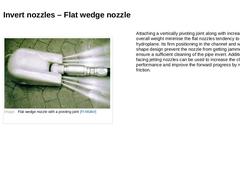
|
(Image: Flat wedge nozzle with a pivoting joint) Attaching a vertically pivoting joint along with increasing its overall weight minimise the flat nozzles tendency to hydroplane. Its firm positioning in the channel and wedge shape design prevent the nozzle from getting jammed and ensure a sufficient cleaning of the pipe invert. Additional front facing jetting nozzles can be used to increase the cleaning performance and improve the forward progress … |
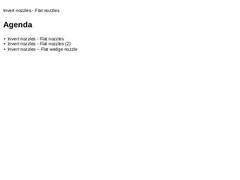
|
|
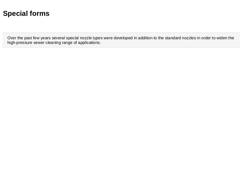
|
Over the past few years several special nozzle types were developed in addition to the standard nozzles in order to widen the high-pressure sewer cleaning range of applications. |
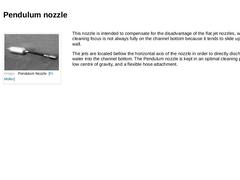
|
This nozzle is intended to compensate for the disadvantage of the flat jet nozzles, whose cleaning focus is not always fully on the channel bottom because it tends to slide up the channel wall. The jets are located bellow the horizontal axis of the nozzle in order to directly discharge the water into the channel bottom. The Pendulum nozzle is kept in an optimal cleaning position by its low centre of gravity, and a flexible … |
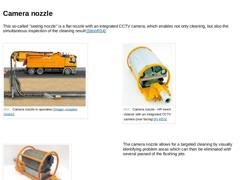
|
This so-called "seeing nozzle" is a flat nozzle with an integrated CCTV camera, which enables not only cleaning, but also the simultaneous inspection of the cleaning result [SteinR04]. (Image: Camera nozzle in operation) (Image: Camera nozzle - HP invert cleaner with an integrated CCTV camera (rear facing)) (Image: Invert nozzle with an integrated CCTV camera) The camera nozzle allows for a targeted cleaning by visually identifying problem areas which … |
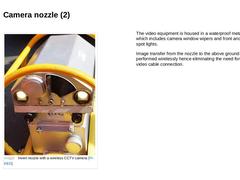
|
(Image: Invert nozzle with a wireless CCTV camera) The video equipment is housed in a waterproof metal housing which includes camera window wipers and front and rear facing spot lights. Image transfer from the nozzle to the above ground receiver is performed wirelessly hence eliminating the need for a direct video cable connection. |
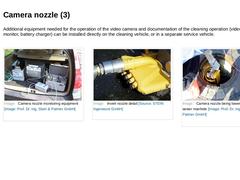
|
Additional equipment needed for the operation of the video camera and documentation of the cleaning operation (video recorder, monitor, battery charger) can be installed directly on the cleaning vehicle, or in a separate service vehicle. (Image: Camera nozzle monitoring equipment) (Image: Invert nozzle detail) (Image: Camera nozzle being lowered into the sewer manhole) |
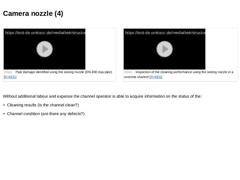
|
(Video: Pipe damage identified using the seeing nozzle) Video: Pipe damage identified using the seeing nozzle (DN 400 clay pipe) [FI-KEG]. This object is only visible in the online version of the module. (Video: Inspection of the cleaning performance using the seeing nozzle in a concrete channel) Video: Inspection of the cleaning performance using the seeing nozzle in a concrete channel [FI-KEG]. This object is only visible in the online version of … |
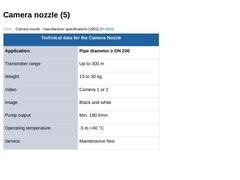
|
(Table: Camera nozzle - manufacturer specifications (2002)) |

|
Based on a similar concept is the "Seeing North Sea nozzle" for the nominal diameter range DN 100 to DN 1000. In this case, it is a radial nozzle with a front camera allowing a look forward. (Image: "Seeing North Sea nozzle") (Image: "Seeing North Sea nozzle") (Image: "Seeing North Sea nozzle") (Image: "Seeing North Sea nozzle") |

|
|

|
The vibrating nozzle is another specially designed tool used in the targeted removal of solidified deposits. The cleaning effect is achieved through the vibration impact of the eccentrically rotating nozzle and the high-pressure jets used for thrust and debris removal. (Image: Vibrating nozzle in operation) |
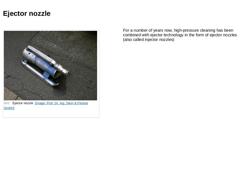
|
For a number of years now, high-pressure cleaning has been combined with ejector technology in the form of ejector nozzles (also called injector nozzles) |
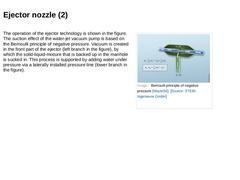
|
The operation of the ejector technology is shown in the figure. The suction effect of the water-jet vacuum pump is based on the Bernoulli principle of negative pressure. Vacuum is created in the front part of the ejector (left branch in the figure), by which the solid-liquid-mixture that is backed up in the manhole is sucked in. This process is supported by adding water under pressure via a laterally installed pressure line (lower branch in the figure). |